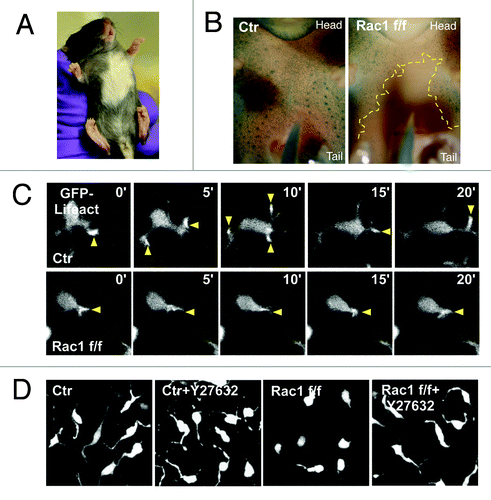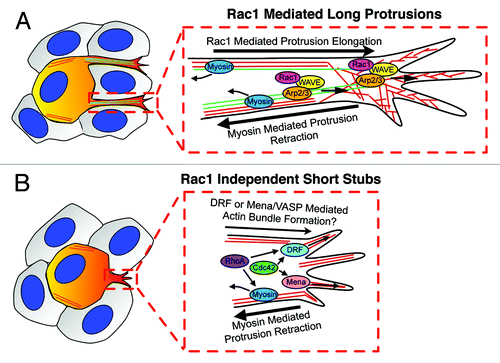Figures & data
Figure 1. Rac1 is required for mouse melanoblast migration. (A) Melanoblast specific deletion of Rac1 results a hypopigmentation in C57BL/6 mice. (B) Ventral surface of β-galactosidase stained whole-mount DCT::LacZ control (left) and Rac1 f/f Tyr::Cre+/o (Right) embryos at E15.5. Yellow dotted line circles the area devoid of melanoblasts (C) Ex-vivo live cell imaging of F-actin dynamics in control (Ctr) or Rac1 depleted (Rac1 f/f) melanoblasts in embryo epidermis explant. Yellow arrows indicate protrusions. (D) Combined Z-stack images (1 μm depth interval) of control or Rac1 depleted melanoblasts in embryo epidermis explant treated with ROCK inhibitor Y27632.

Figure 2. Molecular regulation of formation of long and short protrusions in melanoblasts migration in epidermis during mouse embryogenesis. (A) Rac1 positively regulates the frequency of initiation of long pseudopods, which promote migration speed and allow cells to change their direction of migration. Scar/WAVE and Arp2/3 complex drive actin assembly (red line) for long pseudopod extension, which also depends on microtubule dynamics (green line). Myosin contractility balances the extension of long pseudopods by effecting retraction and allowing force generation for movement through the complex 3D epidermal environment. (B) Short stubs are initiated in a Rac1 independent manner, which is also independent of Arp2/3 complex and microtubules. Short stubs may be initiated by another Rho GTPases such as RhoA or Cdc42 via DRFs or Mena/VASP family proteins. However, none of these alternative mechanisms can produce enough power to oppose myosin contractile activity to drive elongation of short protrusions into long protrusions. melanoblasts are painted with orange and surrounding keratinocytes are colored with gray.
